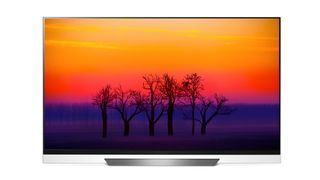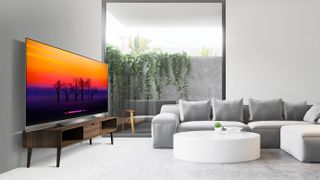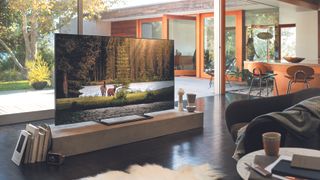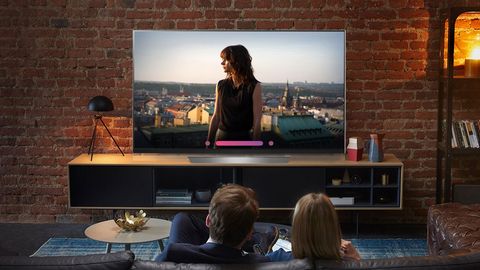TechRadar Verdict
LG returns to the OLED TV fray in 2018 boasting all new designs and, on most of its new OLED models, a powerful new processing system that LG claims unlocks much more of the potential of its premium screen technology. The mid-range OLED65E8 is arguably the ultimate expression of these OLED advances thanks to its glamorous design, niftily integrated sound system and, best of all, mesmerisingly good pictures.
Pros
- +
Awesome picture quality
- +
Opulent and beautiful design
- +
Excellent operating system
- +
Much improved gaming potential
Cons
- -
Occasional picture noise
- -
Lacks brightness vs LCD
- -
Slightly disappointing sound
Why you can trust TechRadar
Without a doubt LG has one of the best OLED TV ranges on the market, and with OLED being the current pinnacle of consumer TVs, the world stops to take notice when LG releases its next set of OLED TVs.
This year, rather than resting on its laurels after the success of the 2017 range, the South Korean company has put a vast amount of work into the processors that go into its OLED range, giving them improvements across the board.
The first OLED to come our way, LG’s 65-inch OLED65E8, arrives with some serious weight resting on its glamorous shoulders. Fortunately for both LG and AV fans, the OLED65E8 raises OLED’s game even further than we’d hoped.

Design
Compared with just about any other 2018 TV you might care to mention, the OLED65E8 looks stunning: The majority of its rear is mind-blowingly thin, and the way it attaches to its minimalist but well made desktop stand using a transparent, full-width ‘neck’ looks so cool it’s almost silly.
Glamorous as the OLED65E8 is, I personally preferred the look of 2017’s E7 OLED predecessor, with its bold integrated soundbar and more extended glass protrusions from all four of the screen’s edges. But maybe that’s just me.
It’s worth noting too, though, that since the OLED65E8 doesn’t join Samsung’s QLED TVs in using an external connection box, you have to run all your source cabling into the TV. And all this cabling is visible through the TV’s glass ‘neck’.
Design TL;DR: While I personally prefer the look of 2017’s E7 series, the OLED65E8 is remains a mesmerisingly gorgeous TV.

Smart TV (webOS with ThinQ AI)

Screen sizes available: 77-inch, 65-inch, 55-inch | Tuner: Freeview HD | 4K: Yes | HDR: Yes (HDR10, Dolby Vision, HLG) | Panel technology: OLED | Smart TV: Yes/webOS 3.5 | Curved: No | Dimensions: 1449(w) x 903(h) x 52(d) mm | 3D: No | Inputs: 4 HDMIs, three USBs, RF tuner
At the heart of the OLED65E8’s smart features lies webOS: LG’s groundbreaking, oft-copied but never bettered interface. This still does a brilliant job of finding and organizing all the myriad content sources available to modern TV viewers, thanks to its simple, attractive layout, and effortless customizability.
LG provides access to all of the main video streaming apps, including the full 4K, HDR implementations of Netflix, Amazon and YouTube. UK users can also benefit from Sky’s Now TV platform, as well as Freeview Play, which provides the catch up TV services of all the main UK terrestrial broadcasters in a handy umbrella interface.
LG in Europe has also recently added Rakuten TV, providing the continent with its first film streaming platform that supports both Dolby Vision HDR and Dolby Atmos sound. The US, of course, can get such streams from VUDU.
WebOS is no longer the be all and end all of LG’s smart features, though. There’s now a much enhanced voice recognition/control system, for instance, which provides straightforward access both to the TV’s features and an exceptionally comprehensive and effective voice search feature. This looks through (some) apps, the internet and the TV listings for answers to your content requests.
The OLED65E8 is compatible with Alexa and, following a recent update, Google Assistant, and even has the potential to monitor and control other devices and appliances on your home network via its ThinQ platform.
Our only issue with webOS is that the single scrolling bar of icons along the bottom of the screen can start to get pretty long once you’ve added a few of your own apps.
Also problematic - especially for us as TV reviewers! - is the way LG continues to put all but the most basic picture adjustments ‘outside’ the webOS interface. This can lead to some pretty convoluted steps to get to any of the TV’s picture and sound adjustments beyond the basic picture presets.
Smart features TL;DR: The OLED65E8 provides a huge range of apps and streaming services within an attractive, easy to follow interface. It’s just a shame the TV’s picture and sound adjustments haven’t been given the webOS treatment.

HD/SDR Performance
OLED has long been a friend to standard dynamic range material. And we really can’t think of any TV that does a better job of showing it than the OLED65E8.
The way each pixel in an OLED screen makes its own light lets the OLED65E8 deliver sensationally deep, rich black colours within which you can pick out subtle shading details that escape pretty much all of the LCD competition.
Being able to deliver such deep black colours without any of the usual low-contrast greyness hanging over them also lets it deliver colours in dark scenes with more punch and naturalism than any non-OLED rival, too.
Actually, colours across the SDR spectrum are delivered with remarkable punch thanks to the richness of the black colour ‘foundation’ the OLED65E8 provides. And LG’s new Alpha 9 processing engine delivers even more subtle, noiseless colour toning than previous LG OLEDs have managed.
The OLED65E8 also handles beautifully even the subtlest of light differences in SDR footage - a talent which joins with its colour and black level prowess and by far the best 4K upscaling of HD sources LG has ever achieved to produce a beautifully detailed-looking, three dimensional picture.
HD/SDR Performance TL;DR: It’s hard to think of a way the OLED65E8 might reasonably have made HD SDR sources look better. Outstanding.

4K/HDR Performance
While OLED TVs have long been considered world beaters with standard dynamic range images, the arrival of high dynamic range has presented the technology with a significant challenge. Not least because OLED technology can’t currently achieve anything like the brightness levels that the best LCD TVs can.
The OLED65E8, though, makes the best case yet for OLED being every bit as compelling as LCD as an HDR display. Just in a different way.
The key to the OLED65E8’s success appears to be its new Alpha 9 processor. For while measurements show that the actual peak brightness of the screen has only gone up a fraction (to around 820 nits on a 10% white window HDR test signals from around 800 nits on last year’s E7 predecessor), its HDR10 pictures nonetheless look much brighter and dynamic. So long, at least, as you make sure you’ve got the new Dynamic Tone Mapping feature activated.
This feature essentially analyses an incoming HDR signal on a scene by scene basis to figure out how best to present it. In other words, it tries to create on the fly for the industry standard HDR10 HDR format the sort of extra image data built into the premium Dolby Vision HDR format.
LG tried a similar thing in 2017 with an Active HDR feature. But the Dynamic Tone Mapping feature is far, far more impressive. Now, at last, we have an OLED TV capable of delivering HDR pictures that actually seem bright and dynamic enough to sometimes, often even, look as punchy as the best HDR LCD TVs.
To be clear, even the OLED65E8 can’t actually reach as far into the brightest end of the potential HDR light spectrum as LCD TVs such as the Sony XE9305 and, especially, the recently reviewed and outstanding Samsung Q9FN. The latter of which can hit north of 2000 nits with its peak brightness measurements.
As a result, it can’t deliver the full extent of HDR’s capabilities, and can fail to resolve some subtle detailing in the very brightest HDR areas. But then LCD TVs can fail to resolve some subtle details in the darkest HDR areas - as well as tending to present the bright parts of predominantly dark HDR pictures with various backlight flaws (striping or blooming) that OLED is immune to.

While the impact of the new Dynamic Tone Mapping feature is the single largest advance the OLED65E8 delivers over last year’s E7 range, its new processing engine also does a great job of combatting many of the niggly problems that occasionally undermined the general brilliance of its predecessor.
There’s also less noise in dark scenes with the OLED65E8 than we’ve seen before with LG OLED TVs. Especially, strangely, if you use the Standard HDR picture preset. Less noise doesn’t mean no noise; there can still be a bit more ‘fizzing’ in the very darkest areas than you tend to get with either some rival brands of OLED TV or the best LCD TVs. But it’s much less common and much less distracting when it does show up than it has been before.
The OLED65E8’s Alpha 9 processor also improves LG’s OLED motion performance, enabling its ‘Clear’ TruMotion setting to reduce judder without causing excessive unwanted side effects or making motion look uncomfortably fluid.
Gamers, meanwhile, will be delighted to hear that unlike its previous two predecessors, the OLED65E8 no longer dims the picture down heavily when running in its low-latency HDR Game mode. It also supports 120fps gaming at HD resolutions, full 4:4:4 PC colour, and a superbly low input lag figure of under 20ms.
One last aspect of the OLED65E8’s mostly magnificent picture performance to cover is its Dolby Vision capabilities. For the most part these yield lovely results; richer, more precise colours from films and TV shows that have been mastered in the premium HDR format, as well as brighter highlights.
There is one downside, though: the occasional appearance of slightly raised black levels during dark scenes when watching Dolby Vision sources via HDMI. This doesn’t happen with all films, and is much subtler than it was with both 2016 and (until a recent firmware update) 2017 OLED models. But Dolby Vision looks so lovely for the rest of the time that anything that detracts from its general gorgeousness can really stand out.
4K HDR TL;DR: A series of significant improvements make the OLED65E8 easily the best picture performer LG’s TV division has ever produced. Which is saying something.

Sound
While LG has made a big leap forward with the OLED65E8’s picture quality, its sound is a step in the opposite direction.
Delivering the new design, with its see-through bottom edge, has meant removing the substantial soundbar attached to last year’s E7 range. And although LG has managed to squeeze a narrow speaker ‘band’ between the screen and this new glass bottom, this bar doesn’t have the breathing space or raw power to deliver the same volumes, dynamic range and sound stage scale delivered by its predecessor.
The sound is still reasonably clean and detailed, and there’s a little vertical and horizontal projection beyond the confines of the TV’s bodywork. But bass is in short supply, and the soundstage doesn’t project far enough to really make much of the TV’s built-in Dolby Atmos decoding.
Sound performance TL;DR: The OLED65E8’s sound is less powerful and dynamic than that of its predecessor, limiting its Dolby Atmos potential.

Other panels to ponder
The most direct rival for the OLED65E8 is Samsung’s QE65Q9FN. Samsung’s set is an LED model with direct lighting and outstanding local dimming that’s capable of hitting brightness peaks at least twice as high as those of the OLED65E8.
This makes it incredibly punchy and dynamic with high dynamic range sources, and it manages to deliver bright highlights in dark scenes with scarcely a trace of the greyness or backlight ‘blooming’ problems typically associated with LCD TVs.
The Samsung model also excels in bright room conditions, thanks to its ground-breaking anti-reflection screen filter.
The LG, though, delivers a much wider viewing angle, and retains more intensity during dark scenes thanks to the way each OLED pixel can produce its own light. The new Dynamic Tone Mapping feature also means that surprisingly it can actually look as bright with mid-bright HDR content as the Samsung - though the Samsung is capable of delivering a more dynamic HDR picture overall.
One other alternative to mention would be LG’s own OLED65C8, which offers the same picture quality but a less glamorous design and less powerful sound system for hundreds less.
Verdict
Having potentially pushed the hardware capabilities of its current OLED screen technology as far as they can go, LG has for 2018 turned its attention to the software that drives these screens - and this shift in focus has yielded surprisingly impressive results, improving and even removing many of the residual niggles associated with 2017’s already in truth outstanding OLED sets.
The OLED65E8 loses a bit of ground sonically from its predecessor, and there’s some stiff competition this year from Samsung’s new Q9FN flagship LCD TV, but all the growing legions of OLED fans will probably need to hear is that the OLED65E8 is comfortably the best OLED TV LG has ever made.
- Confused about OLED? Check out our OLED vs LED and LCD explainer
John has been writing about home entertainment technology for more than two decades - an especially impressive feat considering he still claims to only be 35 years old (yeah, right). In that time he’s reviewed hundreds if not thousands of TVs, projectors and speakers, and spent frankly far too long sitting by himself in a dark room.


